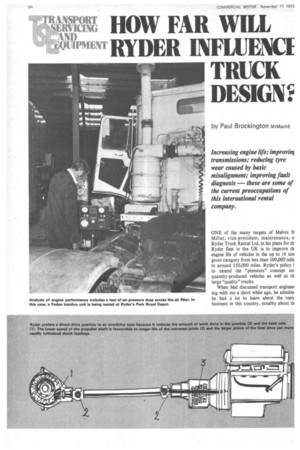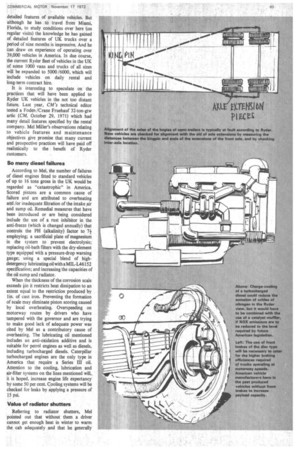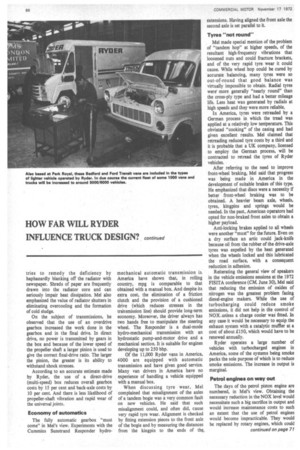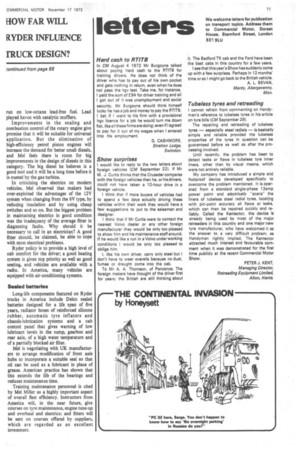VISM HOW FAR WILL
Page 70

Page 71

Page 72

Page 77

If you've noticed an error in this article please click here to report it so we can fix it.
PNIENT RYDER INFLUENCI
TRUCK DESIGN?
by Paul Brockington MiMechE
Increasing engine life; improvin, transmissions; reducing tyre wear caused by basic misalignment; improving fault diagnosis — these are some of the current preoccupations of this international rental company.
ONE of the many targets of Melvin E Miller, vice-president, maintenance, o Ryder Truck Rental Ltd, in his plans for th Ryder fleet in the UK is to improve th engine life of vehicles in the up to 16 ton gross category from less than 100,000 mile to around 150,000 miles. Ryder's policy i to extend the "premium" concept int quantity-produced vehicles as well as th large "quality" trucks.
When Mel discussed transport engineei ing with me a short while ago, he admitte he had a lot to learn about the renti business in this country, notably about th
detailed features of available vehicles. But although he has to travel from Miami, Florida, to study conditions over here (on regular visits) the knowledge he has gained of detailed features of UK trucks over a period of nine months is impressive. And he can draw on experience of operating over 39,000 vehicles in America. In due course, the current Ryder fleet of vehicles in the UK of some 1000 vans and trucks of all sizes will be expanded to 5000/6000, which will include vehicles on daily rental and long-term contract hire.
It is interesting to speculate on the practices that will have been applied to Ryder UK vehicles in the not too distant future. Last year, CM'S technical editor tested a Foden /Crane Fruehauf 32-ton-gtw artic (CM. October 29, 1971) which had many detail features specified by the rental company. Mel Miller's observations relating to vehicle features and maintenance objectives give promise that many current and prospective practices will have paid off realistically to the benefit of Ryder customers.
So many diesel failures
According to Mel, the number of failures of diesel engines fitted to standard vehicles of up to 16 tons gross in the UK would be regarded as "catastrophic" in America. Scored pistons are a common cause of failure and are attributed to overheating and /or inadequate filtration of the intake Air and sump oil. Remedial measures that have been introduced or are being considered include the use of a rust inhibitor in the anti-freeze (which is changed annually) that controls the PH (alkalinity) factor to 74employing; a sacrificial plate of magnesium in the system to prevent electrolysis; replacing oil-bath filters with the dry-element type equipped with a pressure-drop warning gauge; using a special blend of highdetergency lubricating oil with a MIL-L46152 specification; and increasing the capacities of the oil sump and radiator.
When the thickness of the corrosion scale exceeds +in it restricts heat dissipation to an extent equal to the restriction produced by lin. of cast iron. Preventing the formation of scale may eliminate piston scoring caused by local overheating. Overspeeding on motorway routes by drivers who have tampered with the governor and are trying to make good lack of adequate power was cited by Mel as a contributory cause of overheating. The lubricating oil mentioned includes an anti-oxidation additive and is suitable for petrol engines as well as diesels, including turbocharged diesels. Caterpillar turbocharged engines are the only type in America that require a Series III oil. Attention to the cooling, lubrication and air-filter systems on the lines mentioned will, , it is hoped, increase engine life expectancy by some 50 per cent. Cooling systems will be checked for leaks by applying a pressure of 15 psi.
Value of radiator shutters Referring to radiator shutters, Mel pointed out that without them a driver cannot get enough heat in winter to warm the cab adequately and that he generally tries to remedy the deficiency by haphazardly blanking off the radiator with newspaper. Shreds of paper are frequently drawn into the radiator core and can seriously impair heat dissipation. Mel also emphasized the value of radiator shutters in eliminating overcooling and the formation of cold sludge.
On the subject of transmissions, he observed that the use of an overdrive gearbox increased the work done in the gearbox and in the final drive. In direct drive, no power is transmitted by gears in the box and because of the lower speed of the propeller shaft a larger pinion is used to give the correct final-drive ratio. The larger the pinion, the greater is its ability to withstand shock stresses.
According to an accurate estimate made by Ryder, the use of a direct-drive (multi-speed) box reduces overall gearbox costs by 15 per cent and back-axle costs by 10 per cent. And there is less likelihood of propeller-shaft vibration and rapid wear of the universal joints.
Economy of automatics
The fully automatic gearbox "must come" in Mel's view. Experiments with the Cummins Sunstrand Responder hydro
mechanical automatic transmission in America have shown that, in rolling country, mpg is comparable to that obtained with a manual box. And despite its extra cost, the elimination of a friction clutch and the provision of a cushioned drive (which reduces stresses in the transmission line) should provide long-term economy. Moreover, the driver always has two hands free to manipulate the steering wheel. The Responder is a dual-mode hydro-mechanical transmission with an hydrostatic pump-and-motor drive and a mechanical section. It is suitable for engines developing up to 250 bhp.
Of the 11,000 Ryder vans in America, 4000 are equipped with automatic transmission and have given good service. Many van drivers in America have no experience of handling a vehicle equipped with a manual box.
When discussing tyre wear, Mel complained that misalignment of the axles of a tandem bogie was a very common fault on new vehicles. He said that such misalignment could, and often did, cause very rapid tyre wear. Alignment is checked by fitting extension pieces to the front axle of the bogie and by measuring the distances from the kingpin to the ends of the. extensions. Having aligned the front axle the second axle is set parallel to it.
Tyres not round" Mel made special mention of the problem of "tandem hop" at higher speeds, of the resultant high-frequency vibrations that loosened nuts and could fracture brackets, and of the very rapid tyre wear it could cause. While wheel hop could be cured by accurate balancing, many tyres were so out-of-round that good balance was virtually impossible to obtain. Radial tyres were more generally "nearly round" than the cross-ply type and had a better mileage life. Less heat was generated by radials at high speeds and they were more reliable.
In America, tyres were retreaded by a German process in which the tread was applied at a relatively low temperature. This obviated "cooking" of the casing and had given excellent results. Mel claimed that retreading reduced tyre costs by a third and it is probable that a UK company, licensed to employ the German process, will be contracted to retread the tyres of Ryder vehicles.
After referring to the need to improve front-wheel braking, Mel said that progress was being made in America in the development of suitable brakes of this type. He emphasized that discs were a necessity if better front-wheel braking was to be obtained. A heavier beam axle, wheels, tyres, kingpins and springs would be needed. In the past, American operators had opted for non-braked front axles to obtain a higher payload.
Anti-locking brakes applied to all wheels were another "must" for the future. Even on a dry surface an artic could jack-knife because oil from the rubber of the drive-axle tyres was expelled by the heat generated when the wheels locked and this lubricated the road surface, with a consequent reduction in adhesion.
Reiterating the general view of speakers in the vehicle emissions sessions at the 1972 FISITA conference (CM, June 30), Mel said that reducing the emission of oxides of nitrogen was the greatest problem facing diesel-engine makers. While the use of turbocharging could reduce smoke emissions, it did not help in the control of NOX.unless a charge cooler was fitted. In any case it would be necessary to equip the exhaust system with a catalytic muffler at a cost of about £150, which would have to be renewed annually.
Ryder operates a large number of vehicles with turbocharged engines in America, some of the systems being smoke packs the sole purpose of which is to reduce smoke emissions. The increase in output is marginal.
Petrol engines on way out
The days of the petrol piston engine are numbered, in Mel's view. Obtaining the necessary reduction in the NOX level would necessitate such a big sacrifice in output and would increase maintenance costs to such an extent that the use of petrol engines would become impracticable. They would be replaced by rotary engines, which could run on low-octane lead-free fuel. Lead played havoc with catalytic mufflers.
Improvements in the sealing and combustion control of the rotary engine give promise that it will be suitable for universal application. But the elimination of high-efficiency petrol piston engines will increase the 'demand for better small diesels, and Mel feels there is room for big improvements in the design of diesels in this category. The big diesel he believes is a good tool and it will be a long time before it is ousted by the gas turbine.
In criticizing the electrics on modern vehicles, Mel observed that makers had over-exploited the advantages of the 12V system when changing from the 6V type, by reducing insulation and by using cheap switches and so on. But the biggest problem in maintaining electrics in good condition was the inadequacy of the average fitter in diagnosing faults. Why should it be necessary to call in an electrician? A good fitter should, he claimed, be able to cope with most electrical problems.
Ryder policy is to provide a high level of cab comfort for the driver; a good heating system is given top priority as well as good seating, and vehicles are available with a radio. In America, many vehicles are equipped with air-conditioning systems.
Sealed batteries
Long-life components featured on Ryder trucks in America include Delco sealed batteries designed for a life span of five years, radiator hoses of reinforced silicone rubber, automatic tyre inflators and chassis-lubrication systems and a cab control panel that gives warning of low lubricant levels in the sump, gearbox and rear axle, of a high water temperature and of a partially blocked air filter.
Mel is negotiating with UK manufacturers to arrange modification of front axle hubs to incorporate a suitable seal so that oil can be used as a lubricant in place of grease. American practice has shown that this extends the life of the bearings and reduces maintenance time.
Training maintenance personnel is cited by Mel Miller as a highly important aspect of overall fleet efficiency, Instructors from America will, in the near future, give courses on tyre maintenance, engine tune-up and overhaul and electrics: and fitters will be sent on courses offered by suppliers, which are regarded as an excellent investment.
































































































































































